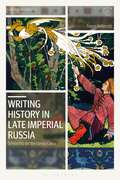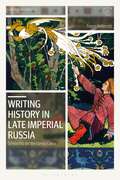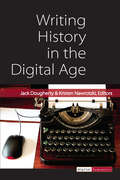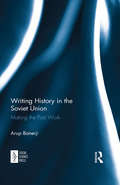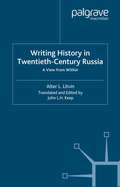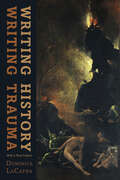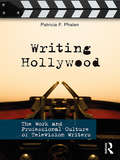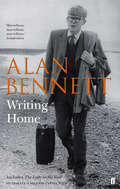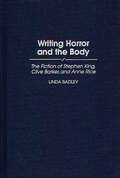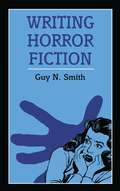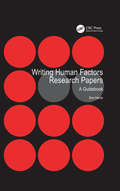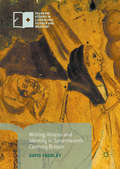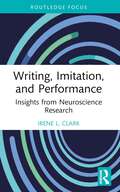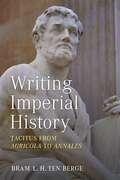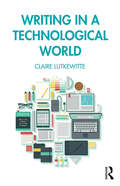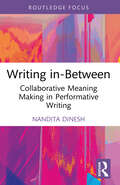- Table View
- List View
Writing History in Late Imperial Russia: Scholarship and the Literary Canon (Library of Modern Russia)
by Frances NethercottIt is commonly held that a strict divide between literature and history emerged in the 19th century, with the latter evolving into a more serious disciple of rigorous science. Yet, in turning to works of historical writing during late Imperial Russia, Frances Nethercott reveals how this was not so; rather, she argues, fiction, lyric poetry, and sometimes even the lives of artists, consistently and significantly shaped historical enquiry. Grounding its analysis in the works of historians Timofei Granovskii, Vasilii Klyuchevskii, and Ivan Grevs, Writing History in Late Imperial Russia explores how Russian thinkers--being sensitive to the social, cultural, and psychological resonances of creative writing--drew on the literary canon as a valuable resource for understanding the past. The result is a novel and nuanced discussion of the influences of literature on the development of Russian historiography, which shines new light on late Imperial attitudes to historical investigation and considers the legacy of such historical practice on Russia today.
Writing History in Late Imperial Russia: Scholarship and the Literary Canon (Library of Modern Russia)
by Frances NethercottIt is commonly held that a strict divide between literature and history emerged in the 19th century, with the latter evolving into a more serious disciple of rigorous science. Yet, in turning to works of historical writing during late Imperial Russia, Frances Nethercott reveals how this was not so; rather, she argues, fiction, lyric poetry, and sometimes even the lives of artists, consistently and significantly shaped historical enquiry. Grounding its analysis in the works of historians Timofei Granovskii, Vasilii Klyuchevskii, and Ivan Grevs, Writing History in Late Imperial Russia explores how Russian thinkers--being sensitive to the social, cultural, and psychological resonances of creative writing--drew on the literary canon as a valuable resource for understanding the past. The result is a novel and nuanced discussion of the influences of literature on the development of Russian historiography, which shines new light on late Imperial attitudes to historical investigation and considers the legacy of such historical practice on Russia today.
Writing History in the Digital Age: Writing History In The Digital Age (Digital Humanities)
by Jack Dougherty Kristen NawrotzkiWriting History in the Digital Age began as a “what-if” experiment by posing a question: How have Internet technologies influenced how historians think, teach, author, and publish? To illustrate their answer, the contributors agreed to share the stages of their book-in-progress as it was constructed on the public web. To facilitate this innovative volume, editors Jack Dougherty and Kristen Nawrotzki designed a born-digital, open-access, and open peer review process to capture commentary from appointed experts and general readers. A customized WordPress plug-in allowed audiences to add page- and paragraph-level comments to the manuscript, transforming it into a socially networked text. The initial six-week proposal phase generated over 250 comments, and the subsequent eight-week public review of full drafts drew 942 additional comments from readers across different parts of the globe. The finished product now presents 20 essays from a wide array of notable scholars, each examining (and then breaking apart and reexamining) if and how digital and emergent technologies have changed the historical profession.
Writing History in the Soviet Union: Making the Past Work
by Arup BanerjiThe history of the Soviet Union has been charted in several studies over the decades. These depictions while combining accuracy, elegance, readability and imaginativeness, have failed to draw attention to the political and academic environment within which these histories were composed. Writing History in the Soviet Union: Making the Past Work is aimed at understanding this environment. The book seeks to identify the significant hallmarks of the production of Soviet history by Soviet as well as Western historians. It traces how the Russian Revolution of 1917 triggered a shift in official policy towards historians and the publication of history textbooks for schools. In 1985, the Soviet past was again summoned for polemical revision as part and parcel of an attitude of openness (glasnost') and in this, literary figures joined their energies to those of historians. The Communist regime sought to equate the history of the country with that of the Communist Party itself in 1938 and 1962 and this imposed a blanket of conformity on history writing in the Soviet Union. The book also surveys the rich abundance of writing the Russian Revolution generated as well as the divergent approaches to the history of the period. The conditions for research in Soviet archives are described as an aspect of official monitoring of history writing. Another instance of this is the manner by which history textbooks have, through the years, been withdrawn from schools and others officially nursed into circulation. This intervention, occasioned in the present circumstance by statements by President Putin himself, in the manner in which history is taught in Russian schools, continues to this day. In other words, over the years, the regime has always worked to make the past work. Please note: Taylor & Francis does not sell or distribute the Hardback in India, Pakistan, Nepal, Bhutan, Bangladesh & Sri Lanka
Writing History in the Soviet Union: Making the Past Work
by Arup BanerjiThe history of the Soviet Union has been charted in several studies over the decades. These depictions while combining accuracy, elegance, readability and imaginativeness, have failed to draw attention to the political and academic environment within which these histories were composed. Writing History in the Soviet Union: Making the Past Work is aimed at understanding this environment. The book seeks to identify the significant hallmarks of the production of Soviet history by Soviet as well as Western historians. It traces how the Russian Revolution of 1917 triggered a shift in official policy towards historians and the publication of history textbooks for schools. In 1985, the Soviet past was again summoned for polemical revision as part and parcel of an attitude of openness (glasnost') and in this, literary figures joined their energies to those of historians. The Communist regime sought to equate the history of the country with that of the Communist Party itself in 1938 and 1962 and this imposed a blanket of conformity on history writing in the Soviet Union. The book also surveys the rich abundance of writing the Russian Revolution generated as well as the divergent approaches to the history of the period. The conditions for research in Soviet archives are described as an aspect of official monitoring of history writing. Another instance of this is the manner by which history textbooks have, through the years, been withdrawn from schools and others officially nursed into circulation. This intervention, occasioned in the present circumstance by statements by President Putin himself, in the manner in which history is taught in Russian schools, continues to this day. In other words, over the years, the regime has always worked to make the past work. Please note: Taylor & Francis does not sell or distribute the Hardback in India, Pakistan, Nepal, Bhutan, Bangladesh & Sri Lanka
Writing History in Twentieth-Century Russia: A View from Within
by A. LitvinIn this fascinating book Alter Litvin tells us what life was really like for professional Soviet historians from Lenin to Gorbachev, and assesses the efforts made since 1991 to create a more truthful picture of the turbulent Russian past. Passionate yet fair-minded, this is the first account of the subject to appear in English. Designed primarily for the general reader, it contains much fresh material of specialist interest and an ample up-to-date bibliography.
Writing History, Writing Trauma (Parallax: Re-visions of Culture and Society)
by Dominick LaCapraTrauma and its aftermath pose acute problems for historical representation and understanding. In Writing History, Writing Trauma, Dominick LaCapra critically analyzes attempts by theorists and literary critics to come to terms with trauma and with the crucial role post-traumatic testimonies—notably Holocaust testimonies—assume in thought and in writing. These attempts are addressed in a series of six interlocking essays that adapt psychoanalytic concepts to historical analysis, while employing sociocultural and political critique to elucidate trauma and its aftereffects in culture and in people. This updated edition includes a substantive new preface that reconsiders some of the issues raised in the book.
Writing History, Writing Trauma (Parallax: Re-visions of Culture and Society)
by Dominick LaCapraTrauma and its aftermath pose acute problems for historical representation and understanding. In Writing History, Writing Trauma, Dominick LaCapra critically analyzes attempts by theorists and literary critics to come to terms with trauma and with the crucial role post-traumatic testimonies�notably Holocaust testimonies�assume in thought and in writing. These attempts are addressed in a series of six interlocking essays that adapt psychoanalytic concepts to historical analysis, while employing sociocultural and political critique to elucidate trauma and its aftereffects in culture and in people. This updated edition includes a substantive new preface that reconsiders some of the issues raised in the book.
Writing Hollywood: The Work and Professional Culture of Television Writers
by Patricia F. PhalenWriting Hollywood highlights the writing process in the production of television drama and comedy series in the U.S. The way writers do their jobs is heavily dependent not only on the demands of commercial business, but also on the uncertainties inherent in a writing career in Hollywood. Drawing on literature in the fields of Media Industry Studies and Occupational Culture, Writing Hollywood explains writers’ efforts to control risk and survive in a constantly changing environment. Using data from personal interviews and a six-week participant observation at a prime time drama, Dr. Phalen analyzes the relationships among writers in series television, describes the interactions between writers and studio/network executives, and explains how endogenous and exogenous pressures affect the occupational culture of the television writing profession.
Writing Hollywood: The Work and Professional Culture of Television Writers
by Patricia F. PhalenWriting Hollywood highlights the writing process in the production of television drama and comedy series in the U.S. The way writers do their jobs is heavily dependent not only on the demands of commercial business, but also on the uncertainties inherent in a writing career in Hollywood. Drawing on literature in the fields of Media Industry Studies and Occupational Culture, Writing Hollywood explains writers’ efforts to control risk and survive in a constantly changing environment. Using data from personal interviews and a six-week participant observation at a prime time drama, Dr. Phalen analyzes the relationships among writers in series television, describes the interactions between writers and studio/network executives, and explains how endogenous and exogenous pressures affect the occupational culture of the television writing profession.
Writing Home
by Alan BennettAlready a bestseller, this is a wonderfully entertaining collection of Alan Bennett's prose writings. Writing Home brings together diaries, reminiscences and reviews to give us a unique and unforgettable portrait of one of England's leading playwrights. As a memoir it covers the production of his very first play, Forty Years On, which starred John Gieldgud. His television series 'Talking Heads' has become a modern-day classic; as part of the 1960s revue 'Beyond the Fringe' Bennett helped to kick-start the English satire revolution, and has since remained one of our leading dramatists, most recently with The History Boys at the National Theatre. At the heart of the book is The Lady in The Van, since adapted into a radio play featuring Dame Maggie Smith. It is the true account of Miss Mary Shepherd, a homeless tramp who took up residence in Bennett's garden and stayed for fifteen years. This new edition also includes Bennett's introduction to his Oscar-nominated screenplay for The Madness of King George and his more recent diaries.
Writing Horror and the Body: The Fiction of Stephen King, Clive Barker, and Anne Rice (Contributions to the Study of Popular Culture)
by Linda BadleyIn this sequel to Film, Horror, and the Body Fantastic, Badley examines horror fiction as a fantastic genre in which images of the body and the self are articulated and modified. Badley places horror fiction in its cultural context, drawing important connections to theories of gender and sexuality. As our culture places increasing importance on body image, horror fiction has provided a language for imagining the self in new ways—often as ungendered, transformed, or re-generated. Focusing on the works of Stephen King, Clive Barker, and Anne Rice, Badley approaches horror as a discourse that articulates the anxieties of our culture.
Writing Horror Fiction (Writing Handbooks)
by Guy N. SmithThis writer's guide explains how to write short stories and horror fiction for children and adults. The author shows how to build on the initial idea and develop characters and plot. There are ideas for selecting and approaching publishers and information about contracts and publication.
Writing Horror Fiction (Writing Handbooks #51)
by Guy N. SmithThis writer's guide explains how to write short stories and horror fiction for children and adults. The author shows how to build on the initial idea and develop characters and plot. There are ideas for selecting and approaching publishers and information about contracts and publication.
Writing Human Factors Research Papers: A Guidebook
by Don HarrisWriting high-quality papers suitable for publication within international scientific journals is now an essential skill for all early-career researchers; their career progression and the reputation of the department in which they work depends upon it. However, many manuscripts are rejected or sent back for major re-working not because the science they contain is in any way 'bad', but because the same problems keep occurring in the way that the material is presented. It is one thing to write a good scientific paper, however it is quite another thing to get it published. This requires some additional nous. In writing this book Don Harris draws upon nearly a quarter of a century of experience as an author and reviewer of research papers, and ultimately as a journal editor. By his own admission, it contains all the things he wished that his mentors had told him 25 years ago, but didn't. The material in the book is drawn from many years of finding all these things out for himself, usually by trial and error (but mostly error!). The text adopts a much lighter touch than is normally found in books of this type - after all, who really wants to read a book about writing research papers? The author describes his own unique approach to writing journal papers (which, in his own words, has proved to be extremely successful). All major points are illustrated with examples from his own, published works. The book is written in the form of a manual for constructing a journal manuscript: read a chapter, write a section. However, the material it contains goes beyond just this and also describes how to select a target journal, the manuscript submission process, what referees are looking for in a good journal paper, and how to deal with the referees' comments. Each chapter concludes with a checklist to ensure all the key elements have been addressed.
Writing Human Factors Research Papers: A Guidebook
by Don HarrisWriting high-quality papers suitable for publication within international scientific journals is now an essential skill for all early-career researchers; their career progression and the reputation of the department in which they work depends upon it. However, many manuscripts are rejected or sent back for major re-working not because the science they contain is in any way 'bad', but because the same problems keep occurring in the way that the material is presented. It is one thing to write a good scientific paper, however it is quite another thing to get it published. This requires some additional nous. In writing this book Don Harris draws upon nearly a quarter of a century of experience as an author and reviewer of research papers, and ultimately as a journal editor. By his own admission, it contains all the things he wished that his mentors had told him 25 years ago, but didn't. The material in the book is drawn from many years of finding all these things out for himself, usually by trial and error (but mostly error!). The text adopts a much lighter touch than is normally found in books of this type - after all, who really wants to read a book about writing research papers? The author describes his own unique approach to writing journal papers (which, in his own words, has proved to be extremely successful). All major points are illustrated with examples from his own, published works. The book is written in the form of a manual for constructing a journal manuscript: read a chapter, write a section. However, the material it contains goes beyond just this and also describes how to select a target journal, the manuscript submission process, what referees are looking for in a good journal paper, and how to deal with the referees' comments. Each chapter concludes with a checklist to ensure all the key elements have been addressed.
Writing Illness and Identity in Seventeenth-Century Britain (Palgrave Studies in Literature, Science and Medicine)
by David ThorleyThis book is a survey of personal illness as described in various forms of early modern manuscript life-writing. How did people in the seventeenth century rationalise and record illness? Observing that medical explanations for illness were fewer than may be imagined, the author explores the social and religious frameworks by which illness was more commonly recorded and understood. The story that emerges is of illness written into personal manuscripts in prescriptive rather than original terms. This study uncovers the ways in which illness, so described, contributed to the self-patterning these texts were set up to perform.
Writing, Imitation, and Performance: Insights from Neuroscience Research (Routledge Research in Writing Studies)
by Irene L. ClarkThis book reconsiders imitation as a valuable pedagogical approach in Writing Studies. Countering concerns about product-oriented teaching, formulaic writing, paternalistic or elitist pedagogy, and plagiarism, the book maintains that the use of imitation can offer a writer greater insight and help to develop a clear writerly identity. Positing that writers often use imitation as a step toward developing new directions, structures, and styles, and that this imitation is indeed a form of performance, the author explores the neuropsychological aspect of imitation to show how it is a valid form of writing instruction. She explains how learning, experience, and role playing are manifested in the brain and influence one’s sense of self, one’s identity. The book emphasizes that imitation can provide students with opportunities to perform habitually as writers, readers, and critical thinkers, enabling them to develop new understandings and confidence in their ability to improve. It also includes suggestions for classroom application, written by Craig A. Meyer. This book offers important insights for scholars and teachers of writing and composition, education, and communication studies.
Writing, Imitation, and Performance: Insights from Neuroscience Research (Routledge Research in Writing Studies)
by Irene L. ClarkThis book reconsiders imitation as a valuable pedagogical approach in Writing Studies. Countering concerns about product-oriented teaching, formulaic writing, paternalistic or elitist pedagogy, and plagiarism, the book maintains that the use of imitation can offer a writer greater insight and help to develop a clear writerly identity. Positing that writers often use imitation as a step toward developing new directions, structures, and styles, and that this imitation is indeed a form of performance, the author explores the neuropsychological aspect of imitation to show how it is a valid form of writing instruction. She explains how learning, experience, and role playing are manifested in the brain and influence one’s sense of self, one’s identity. The book emphasizes that imitation can provide students with opportunities to perform habitually as writers, readers, and critical thinkers, enabling them to develop new understandings and confidence in their ability to improve. It also includes suggestions for classroom application, written by Craig A. Meyer. This book offers important insights for scholars and teachers of writing and composition, education, and communication studies.
Writing Imperial History: Tacitus from Agricola to Annales
by Bram ten BergeThe late first- and early second-century Roman senator and historian Cornelius Tacitus, whom Edward Gibbon described as “the first of the historians who applied the science of philosophy to the study of facts,” shaped the development of the modern understanding of history as a crucial vehicle for social analysis. The breadth of his thinking is fully revealed only through analysis of how the political, geographical, and rhetorical theories expounded in his early works influenced his later narrative of the evolution of the Roman monarchy. Tacitus, who was one of the oratorical luminaries of his time, produced a collection of works widely recognized as offering the most authoritative account of Rome’s early imperial history. His oeuvre traditionally is divided into the so-called minor and major works. Writing Imperial History offers the first comprehensive analysis of Tacitus’ five texts and their interconnections and serves to confront longstanding assumptions that have led to a fundamental misunderstanding of the nature and development of his oeuvre and historical thinking. Tracing many of the enduring themes and concerns that Tacitus explores across his works, the book shows how the vision articulated in his earlier texts persists in his later ones and how he used the former as sources for the latter.
Writing in a Technological World
by Claire LutkewitteWriting in a Technological World explores how to think rhetorically, act multimodally, and be sensitive to diverse audiences while writing in technological contexts such as social media, websites, podcasts, and mobile technologies. Claire Lutkewitte includes a wealth of assignments, activities, and discussion questions to apply theory to practice in the development of writing skills. Featuring real-world examples from professionals who write using a wide range of technologies, each chapter provides practical suggestions for writing for a variety of purposes and a variety of audiences. By looking at technologies of the past to discover how meanings have evolved over time and applying the present technology to current working contexts, readers will be prepared to meet the writing and technological challenges of the future. This is the ideal text for undergraduate and graduate courses in composition, writing with technologies, and professional/business writing. A supplementary guide for instructors is available at www.routledge.com/9781138580985
Writing in a Technological World
by Claire LutkewitteWriting in a Technological World explores how to think rhetorically, act multimodally, and be sensitive to diverse audiences while writing in technological contexts such as social media, websites, podcasts, and mobile technologies. Claire Lutkewitte includes a wealth of assignments, activities, and discussion questions to apply theory to practice in the development of writing skills. Featuring real-world examples from professionals who write using a wide range of technologies, each chapter provides practical suggestions for writing for a variety of purposes and a variety of audiences. By looking at technologies of the past to discover how meanings have evolved over time and applying the present technology to current working contexts, readers will be prepared to meet the writing and technological challenges of the future. This is the ideal text for undergraduate and graduate courses in composition, writing with technologies, and professional/business writing. A supplementary guide for instructors is available at www.routledge.com/9781138580985
Writing In Action (PDF)
by Paul MillsWriting in Action provides a step-by-step, practical guide to the process of writing. Although the emphasis is on creative writing, fiction, poetry and drama, it also covers autobiographical writing, the writing of reports and essays. Because this is a book about process, rather than product, Writing in Action also looks at the practice of adaptation and editing. Writing in Action: shows new writers how to get started develops the confidence of more experienced writers encourages experimentation and creativity stimulates critical awareness through inclusion of illustrative texts encourages writing as a skill, as well as an art-form Writing in Action enables new writers to get close to the experience of writing; the questions writers ask, and the choices they make. The book is crammed with practical suggestions and self-evaluation exercises, as well as invaluable tips on style, sentence structure, punctuation and vocabulary. This is an ideal course text for students and an invaluable guide to self-study.
Writing in Bereavement: A Creative Handbook (Writing for Therapy or Personal Development)
by Jane MossThis practical creative handbook provides imaginative writing exercises for counsellors, volunteers and others working with the bereaved, and offers advice on how to plan and run effective group workshops and individual sessions. Through writing, clients are helped to communicate their experiences of grief and adjust to life after their loss.
Writing in-Between: Collaborative Meaning Making in Performative Writing (Routledge Focus on Literature)
by Nandita DineshWriting in-Between lies at intersections: between theory and praxis; between fiction and non-fiction; between author and reader; between the personal and the political. Beginning with a conceptual glossary that prepares readers for their journey through the book, Dinesh offers two central texts to invite readers to become co-creators. The first, F for _____, is written as an “academic novella” and culminates with an interactive section that is composed of guided invitations for the reader/co-creator. The second text, Julys, takes the form of a “dramatic memoir” and intersperses invitations for readers/co-creators between each of its chapters. Dinesh brings these threads together in an entirely interactive concluding chapter, where her hopes for collaborative meaning making take centre stage. In all of its unique invitations to engage, Dinesh’s readers/co-creators can either choose to craft their creations in personal notebooks or blank spaces in this work’s physical copy, or to engage more publicly via virtual forums that can be accessed via QR codes and accompanying links that are scattered throughout the book. Guided by questions about writing can “do” — questions that have shaped Dinesh’s work as an artist, scholar, and educator for almost two decades — Writing in Between embodies one central tenet: that the significance of performative writing might be most powerfully experienced through a collaborative process of meaning making between a text’s author and its readers turned co-creators.
